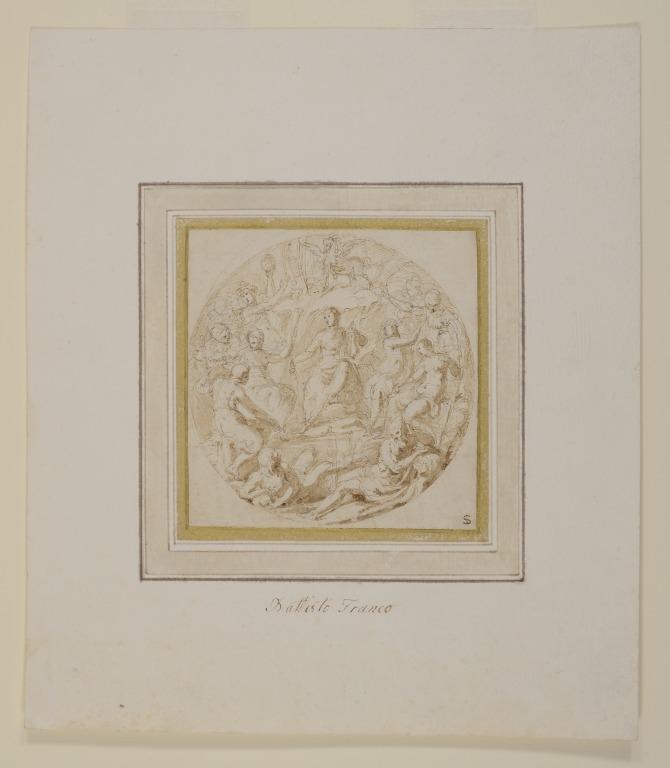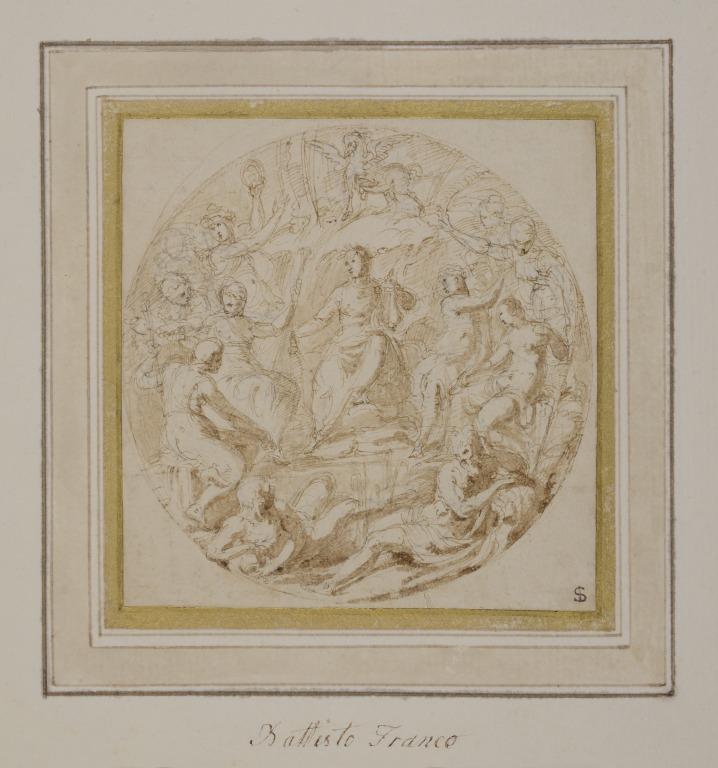
Apollo and the Muses on Mount Parnassus with Two River Gods
Giovanni Battista Franco, 1545 - 1551
WAG 1995.320
Information
In ancient Greek mythology, Apollo was the god of the sun, music and poetry, and the Muses were goddesses of creative arts. Today, the term muse is often used to refer to a passive person or object who inspires usually masculine creativity. However, the Muses were originally seen as active creators who shared their knowledge and creativity with artists, writers and poets who asked for their help. The circular design of this drawing has led people to suppose that it may have been a design for a maiolica plate produced between 1545-1551 when the artist was working for Guidobaldo II della Rovere, Duke of Urbino, at the ceramic works of Castel Durante. However, the format and style of the composition is untypical of maiolica designs: it is allegorical rather than narrative and lacks both the usual arrangement of figures stretched across the foreground in a frieze-like composition, and a brim around which a separate design is worked.
Although the subject of Apollo and the Muses occasionally appears on decorated ceramics, it does not seem to be connected to either of the two series Franco is known to have worked at Urbino: one relating to the story of Troy and the other to Hercules. This drawing may instead have been designed for a painted roundel, to be seen from below, in a decorative scheme for a ceiling.
During the last few years of his life, Franco worked on several such projects in Venetian palaces and libraries. From 1556 to 1557 he painted three of the ceiling tondi of the Libreria Marciana with circular representations of allegorical figures, none of which depicted Apollo. But as the theme of Apollo and the Muses was so appropriate for a library, it is possible that the design was intended for the Libreria Vecchia where Franco worked in 1559-1560. He painted eleven panels of gods and allegorical figures on the lower flight of the staircase and in the antechamber he painted "Apollo playing the Lyre surrounded by Mercury, Amore, Neptune and Falsehood". None of these have survived the alterations made by Giovanni Grimani in 1577 and the subsequent dispersal of works.
Another slightly larger pen and ink drawing of the same subject (but without the addition of wash and with the 9th Muse on the right) appears to be a copy drawing also attributed to Battista Franco now on loan to the Snite Museum of Art, University of Notre Dame, Indiana.
Specifications
- Accession number
- WAG 1995.320
- Collection type
- Drawing or Watercolour - Drawing
- Artist
- Giovanni Battista Franco
- Place made
- Europe: Southern Europe: Italy: Urbino
- Date made
- 1545 - 1551
- Materials
- Paper; Black chalk; Ink; Pen; Wash
- Measurements
- Paper: 11.1 cm x 10.7 cm; Image: 11 cm x 10.6 cm
- Credit line
- Legal status
- Permanent collection
- Provenance
- Location
- Item not currently on display
- Inscription
- Inscription, Ink, Front; Mount; Lower centre: Battisto Franco
- Publications
- Mantegna to Rubens: The Weld-Blundell Drawings Collection, Xanthe Brooke, 1998
1of3


